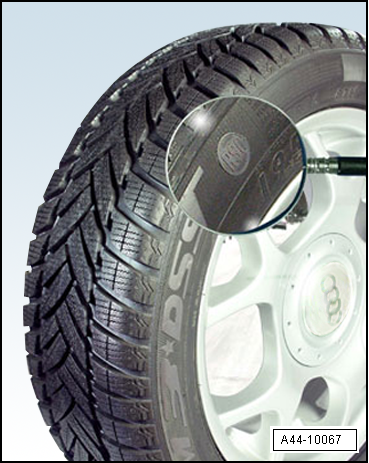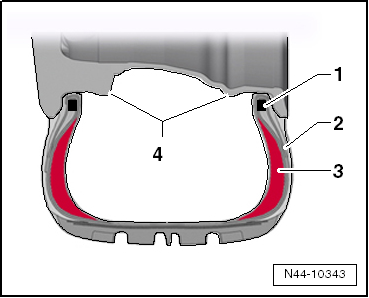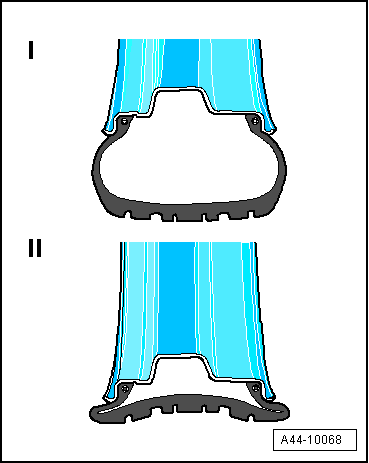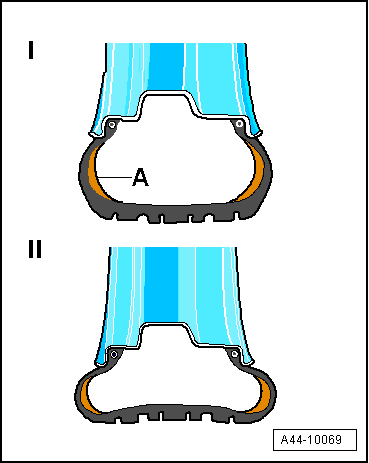Volkswagen Polo Service & Repair Manual: Run-Flat Tire, Structure and Identification, SST Tire
| Run-Flat Tires, Dismounting and Mounting. Refer to
→ Chapter „Tires, Mounting“. |
| A Tire Pressure Monitoring Display is Necessary When Using
Run-Flat Tires. |
| Tire Damage and the Pressure Loss Resulting From it is Not
Always Recognizable. |
|
|
|
| SST tires are identified with a special code (RSC = Run-flat
System Component) on the side wall. |
| The Identification on the Side Wall of Run-Flat Tires can
Differ Depending on the Manufacturer. |
| Self-Supporting Tire stands for a tire system with emergency
running characteristics in the event of a loss of pressure. In
the event of a flat tire, the driver can continue driving to a
limited extent to the next workshop Owner's Manual. |
| SST tires make it possible to drive up to 50 km at a maximum
of 80 km/h (49.7 mph) even with a complete loss of pressure. |
| Driving style, speed, road surface, weather conditions, tire
condition and tire load influence the distance. |
| With SST tires, it is not necessary to immediately change a
tire when it suffers from a complete loss of pressure (e.g. no
tire changing in an area with low visibility or in dangerous
conditions). |
| Braking, steering and driving performance remain for the
most part after the tire looses pressure. |
| A spare wheel is no longer necessary when using SST tires.
From the view of the customer, this means: saving space and
weight. |
|
|

|
| 1 - |
Bead with bead bundle |
| 3 - |
Sidewall reinforcement |
| 4 - |
Rim with extended hump (EH2) on both sides - required when
using run-flat tires |
| Standard Tires Without Emergency Running Characteristics |
|
|

|
| – |
-I- standard tires with air. |
| – |
-II- standard tires without
air. |
| – |
If the standard tire loses air, the rim presses the side
wall together. The rubber in a flat tire is heated strongly and
quickly loses its properties. |
| SST Tires with Reinforced Side Wall |
| The self-supporting, reinforced side walls form the basis of
SST technology. |
|
|

|
| – |
-I- SST tires with air. |
| – |
-II- SST tires without air. |
| – |
Especially thick side walls -A-
support the empty tires on a standard rim and the vehicle
remains maneuverable. A special rubber mixture reinforces the
tires and supports the vehicle in an emergency. |
| The reinforced side walls, unlike a standard tire, prevent
the tire flanks from pinching between the road and rim when
flat. |
| Difference in Version H2 and EJ2 Extended Hump Rim
|
| The increased hump on the EH2 Extended Hump Rim prevents the
SST tire from springing off when pressure is lost. |
| EH2 builds up toward the center of the wheel. |
 WARNING
WARNING
| The clearance to the brake is reduced. |
|
|
|

|
1 -
Tread Block
2 -
Tread Groove
3 -
Tread
4 -
Nylon Ply
5 -
Belt ...
The vehicle can be equipped with run-flat tires as an
option.
The Seal Inside technology is a system that allows the
vehicle to continue ...
Other materials:
Pneumatic Brush Grinder Set -VAS6446
Definition:
Pneumatic Brush Grinder Set -VAS6446-
Product Description:
The Pneumatic Brush Grinder Set -VAS6446- serves to prepare
the surface.
For example: removes underbody ...
Description and function of the airbags
First read and observe the introductory information
and safety warnings
The airbags can protect vehicle occupants during frontal and side collisions
by reducing their movement in the direction of the collision.
When an airbag is triggered, it is inflated by a gas generator. This causes the
...
AGM Battery, Checking
Perform Battery Checks in the Following Sequence:
1.
Visual inspection. Refer to
→ Chapter „Visual Inspection“.
2.
Check the battery using the Battery Tester -VAS6161-. Refer
to
...
© 2016-2025 Copyright www.vwpolo.net

 Cross-Section of a Radial Ply Tire
Cross-Section of a Radial Ply Tire Run-Flat Tire, Seal Inside-Technology
Run-Flat Tire, Seal Inside-Technology



 WARNING
WARNING